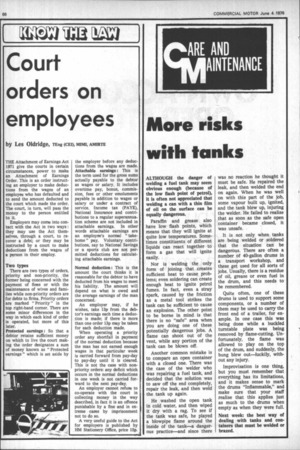ARE AND AINTENANCE More risks with tanks
Page 68

If you've noticed an error in this article please click here to report it so we can fix it.
ALTHOUGH the danger of welding a fuel tank may seem obvious enough (because of the low flash point of petrol), it is often not appreciated that welding a can with a thin film of oil on the surface can be equally dangerous.
Paraffin and grease also have low flash points, which means that they will ignite at quite low temperatures. Sometimes constituents of different liquids can react together to form a gas that will ignite easily.
Nor is welding the only form of joining that creates sufficient heat to cause problems; even soldering can create enough heat to ignite petrol fumes. In fact, even a stray spark, caused by the friction as a metal tool strikes the tank can be sufficient to cause an explosion. The other point to be borne in mind is that there is no "safe" area when you are doing one of these potentially dangerous jobs. A flame can shoot out of the vent, while any portion of the tank can be blown off.
Another common mistake is to compare an open container with a closed one. There was the case of the welder who was repairing a fuel tank, and decided that the solution was to saw off the end completely, repair the leak, and then weld the tank up again.
He washed the open tank in cold water, and then wiped it dry with a rag. To see if the tank was safe, he played a blowpipe flame around the inside of the tank—a dangerous practice—and since there was no reaction he thought it must be safe. He repaired the leak, and then welded the end on again. When he was well on with this part of the job, some vapour built up, ignited, and the tank blew up, injuring the welder. He failed to realise that as soon as the safe open container became closed, it was unsafe.
It is not only when tanks are being welded or soldered that the situation can be dangerous. There are often a number of 40-gallon drums in a transport workshop, and these get used for all sorts of jobs. Usually, there is a residue of oil, grease or even fuel in the drum, and this needs to be remembered.
Quite often, one of these drums is used to support some components, or a number of them may be used to carry the front end of a trailer, for example. In one case this was being done while a buckled turntable plate was being removed by flame-cutting. Unfortunately, the flame was allowed to play on the top of the drum, and suddenly, the bung blew out—luckily, without any injury.
Improvisation is one thing, but you must remember that everything has its limitations, and it makes sense to mark the drums "Inflammable," and make sure that your staff realise that this applies just as much to the drums when empty as when they were full.
Next week: the best way of dealing with tanks and containers that must be welded or brazed.




























































































































